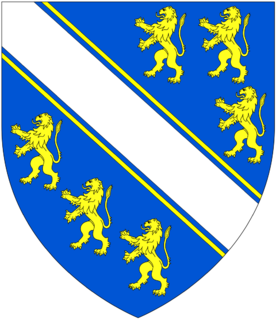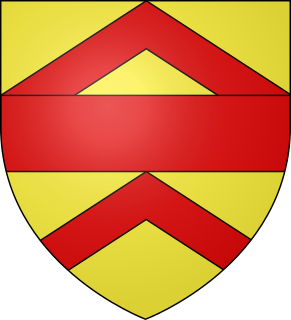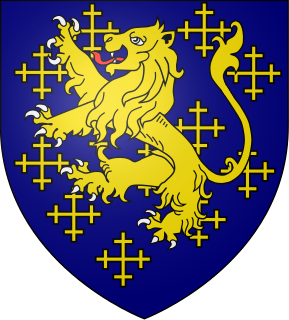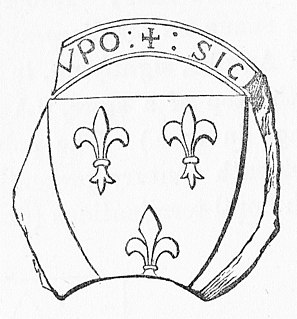Related Research Articles
Roger Bigod was a Norman knight who travelled to England in the Norman Conquest. He held great power in East Anglia, and five of his descendants were earls of Norfolk. He was also known as Roger Bigot, appearing as such as a witness to the Charter of Liberties of Henry I of England.

Henry de Bohun, 1st Earl of Hereford of Pleshy Castle in Essex, was an Anglo-Norman nobleman who became Hereditary Constable of England from 1199.
Roger de Montgomery, also known as Roger the Great de Montgomery, was the first Earl of Shrewsbury, and Earl of Arundel, Sussex. His father was Roger de Montgomery, seigneur of Montgomery, and was a relative, probably a grandnephew, of the Duchess Gunnor, wife of Duke Richard I of Normandy. The elder Roger had large holdings in central Normandy, chiefly in the valley of the Dives, which the younger Roger inherited.

John de Balliol was a leading figure of Scottish and Anglo-Norman life, belonging to the House of Balliol. Balliol College, in Oxford, is named after him.
Sir Robert de Ros was an English nobleman.
John Fitzalan, 3rd Lord of Clun and Oswestry (1200–1240) in the Welsh Marches in the county of Shropshire.

William III de Ferrers, 5th Earl of Derby of Chartley Castle in Staffordshire, was an English nobleman and major landowner, unable through illness to take much part in national affairs. From his two marriages, he left numerous children who married into noble and royal families of England, France, Scotland and Wales.

Aubrey de Vere, 2nd Earl of Oxford, hereditary Master Chamberlain of England, served in military campaigns under King Richard and King John. He was succeeded in the earldom by his brother, Robert de Vere, 3rd Earl of Oxford.

Robert FitzWalter, 1st Baron FitzWalter was an English peer.

Walter de Lacy was lord of Meath in Ireland. He was also a substantial land owner in Weobley, Herefordshire, in Ludlow, Shropshire, in Ewyas Lacy in the Welsh Marches, and several lands in Normandy. He was the eldest son of Hugh de Lacy, a leading Cambro-Norman baron in the Norman invasion of Ireland, and Rohese of Monmouth.

Robert de Vere, hereditary Master Chamberlain of England, was son of Aubrey de Vere, 1st Earl of Oxford, and Agnes of Essex. He succeeded his brother as the third Earl of Oxford, and was one of the twenty-five guarantors of Magna Carta.

William de Braose, was the first Baron Braose, as well as Lord of Gower and Lord of Bramber.

William I de Cantilupe 1st feudal baron of Eaton (Bray) in Bedfordshire, England, was an Anglo-Norman royal administrator who served as steward of the household to King John and as Baron of the Exchequer.

Hugh de Neville was the Chief Forester under the kings Richard I, John and Henry III of England; he was the sheriff for a number of counties. Related to a number of other royal officials as well as a bishop, Neville was a member of Prince Richard's household. After Richard became king in 1189, Neville continued in his service and accompanied him on the Third Crusade. Neville remained in the royal service following Richard's death in 1199 and the accession of King John to the throne, becoming one of the new king's favourites and often gambling with him. He was named in Magna Carta as one of John's principal advisers, and considered by a medieval chronicler to be one of King John's "evil counsellors". He deserted John after the French invasion of England in 1216 but returned to pledge his loyalty to John's son Henry III after the latter's accession to the throne later that year. Neville's royal service continued until his death in 1234, though by then he was a less significant figure than he had been at the height of his powers.

Robert Marmion was an Anglo-Norman nobleman and rebel involved in the First Barons' War. He was referred to as "Robert Marmion the Younger" as his elder half-brother was also called Robert and known as "Robert Marmion the Elder".

The Constable of Chester was a mediaeval hereditary office appointed by the Earl of Chester, Count Palatine, within his princely quasi-autonomous County Palatine of Chester. The functions of the Constable are unclear, possibly they related to the custody of Chester Castle, as was the main function of most mediaeval constables, but Sanders (1960) says the office-holder was constable for the entire County Palatine.

Peter FitzHerbert, also known as Piers FitzHerbert, Lord of Blenlevenny, was a 13th and 14th century nobleman and Sheriff of Yorkshire. FitzHerbert was one of the Counsellors named in Magna Carta in 1215. He was the son of Herbert FitzHerbert and Lucy of Hereford.

Reginald FitzPiers, also known as Reynold FitzPiers, Lord of Blenlevenny was a 13th-century English nobleman and Sheriff of Hampshire. He was the second son of Peter FitzHerbert and Alice de Warkworth, and following the death of his brother inherited the minor Marcher Lordship of Blaenllynfi from him.
William de Ros, Lord of Helmsley, was an English noble. He was the eldest son of Robert de Ros and Isabella Mac William.
Peter FitzReginald, also known as Piers FitzReynold, Lord of Chewton was an English noble.
References
- Cokayne, George Edward (1926). The complete peerage of England, Scotland, Ireland, Great Britain and the United Kingdom, extant, extinct or dormant, Volume 5. London: St. Catherine Press.
- Collins, Arthur. The Peerage of England; containing a genealogical and historical account of all the peers of England, now existing, etc, Volume 2. W. Innys; R. Manby; T. Wotton & F. Gosling, 1741.